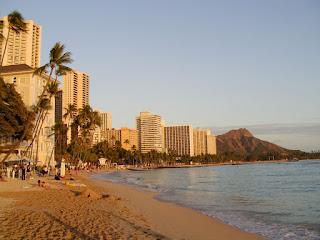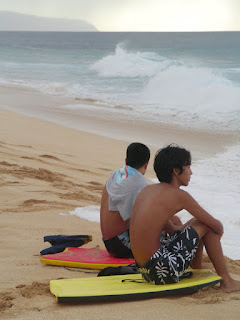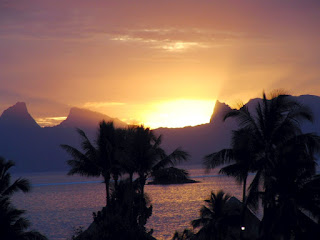Garry and I were reminiscing recently with friends. They’d just returned from their first cruise, a voyage to New Caledonia and the Loyalty Islands. Their anecdotes brought back memories of our first cruise in July 2004. At the time, Garry’s cousin, a travel agent, offered us a discounted, last-minute porthole stateroom cruising Tahiti on the Paul Gauguin. On a whim, we decided to book it.

A few weeks later, we flew out for Papeete. Our flight arrived late so we booked ourselves into the Hilton Hotel for an overnight stay. The following day we woke to perfect tropical weather. A pattern that persisted for our entire time in Tahiti. After a complimentary breakfast, we retired to a couple of sun loungers for a lazy morning by the hotel pool.
Later that afternoon we checked out and made our way onboard the Paul Gauguin. This is a relatively small and intimate cruise ship. It carries a maximum of 330 guests, who are attended to by a total of 209 crew. Despite its compact size, the boat boasts three superb restaurants including a fine-dining venue called L’etoile.
For the next seven days, we cruised through some of the South Pacific’s most picturesque islands. Our first night on board saw us set sail for Raiatea and Tahaa. We woke the following morning to be greeted by stunning views of a lush, mountainous island enclosed by an equally stunning lagoon. The largely unspoiled shoreline was dotted with small villages and fringed by palm trees.
Raiatea and Tahaa share the same fringing reef. The captain took advantage of this unique phenomenon. We sailed through a narrow reef break in Raiatea and traced a route along Raiatea's northwestern coast before crossing over to Tahaa. It’s hard to describe the breathtaking beauty of such an expansive lagoon.
For example, as we sailed along Tahaa's west coast, a photogenic red-roof protestant church in Tiva sailed into view. This simple structure, surrounded by a low brick wall, sits right on the water's edge. Its dazzling white facade stands in stark contrast to the tropical wilderness that surrounds it. Interestingly, Tahaa is Tahiti's largest producer of vanilla pods. It's responsible for more than 80% of the nation's annual production of this fragrant spice.
After a morning of lagoon cruising we dropped anchor at Motu Mahana, an idyllic white sand island on Tahaa’s western fringe reef. The crew set up a private playground for us to enjoy. This includes a floating cocktail bar, deck chairs set along the tide line so that we could dangle our feet in the water, and a sumptuous BBQ lunch.
I made good use of the complementary snorkelling gear and swam out to explore the coral. Sadly, the colourful underwater seascape I’ve previously enjoyed off Port Douglas was nowhere to been seen. Instead, largely barren rock and dead, broken coral covered the lagoon floor. Although, much to my surprise, the dilapidated reef was still teeming with life including schools of adorable little Zebra fish.
However, the real highlight of our cruise came on 21 July. This was the morning we glided into the truly spectacular Bora Bora lagoon. Our first glimpse of its iridescent surface, framed by the iconic Mount Otemanu, was simply breathtaking. It’s easy to see why the French impressionist painter, Paul Gauguin, fell in love with this island.
Our boat spent two nights moored in the Bora Bora lagoon. Garry and I took advantage of the extended stop and booked two memorable excursions. The first was an outing into a remote corner of the lagoon to feed wild manta rays. To this day, we still talk about the unique experience of being relentlessly “humped” by a school of hungry rays.
Our guide led us into the water where we stood waist-deep and hand-fed dozens of extremely friendly rays. These hungry creatures swarmed us, riding up our backs and thighs, often without warning, as they fought to get to the food on offer. In the distance, timid reef sharks continually circled but never ventured close enough to make us panic.
Our second excursion saw us spend an afternoon circumnavigating Bora Bora on ski jets. Our tour guide took us on an exhilarating ride around the dazzling aquamarine lagoon that encircles the island. Our excursion included a brief stop on the island’s far side. Here we beached our jet skis, quenched our thirst with freshly shucked coconut water and, watched local artisans at work.
For the final two days of our cruise we sailed to Moorea, Tahiti’s second largest island. The boat then anchored overnight in Cook’s Bay. We spent most of our time onboard lazing by the pool. We’d booked three nights at the Hilton Moorea Lagoon Resort immediately after our cruise, so we saw limited value in exploring the island while still onboard the Paul Gauguin.
After docking back in Papeete, Garry and I caught a morning ferry back to Moorea and checked into the Hilton. I’d booked us an overwater lagoon bure. The room featured a private balcony with stairs that stepped directly into the lagoon. The lounge floor also featured a glass panel that let us observe fish swimming below.
While in Moorea we hired a couple of Vespa scooters and spent a day encircling the island. Our circuit included a detour to enjoy views of Opunohu Valley from Belvedere Lookout, a stop to explore the decaying stone Ahu platforms at Marae Titiroa and a photographic stop at the island’s iconic Eglisede la Sainte Famille Church.
The church is an attraction I recalled from my first visit to Moorea back in 1999. This white, twin-spired chapel, built in 1897, has long been a popular subject for painters and photographers the world over. However, while it celebrates the joy of Christ, other locations on the island like Marae Titiroa, bear witness to Christianity’s darker history.



The marae was once the island’s centre of worship. However, early missionaries removed the idols that stood along its stone ahu platform and threw them into the sea. The site was subsequently abandoned as the native population was converted to Christianity. Today very little is known about these ancient sites or the rituals they promoted.
A quick shoutout for the classic tourist photo we took from Moorea's Toatea Lookout. This hilltop location delivers a stunning idyllic view across the island's eastern lagoon, framed by a string of picturesque overwater bungalows at the Sofitel Kiaora Resort. This is the image you can see above.
Our final night in Tahiti was spent at the Intercontinental Hotel near Papeete’s international airport. It was here we witnessed one of the island’s most extraordinary sights. The hotel is perfectly located for a truly spectacular sunset. As the sun sets behind neighbouring Moorea Island, its dying rays flare through Moorea's peaks and set the sky alight with dramatic shadows framed by golden streaks. Early the following morning we flew home with Air Tahiti Nui.
The image above of the Paul Gauguin was taken from a ferry we caught back to Moorea after disembarking on 25 July. The boat docked shortly after 7:00am. This meant we got to enjoy another full day on Moorea once we'd checked into our hotel. We stayed an additional two nights, three days, on Moorea. I'm not sure about the grey smudges? If memory serves me well it's smoke haze blowing towards us from the ferry's funnel.














































































